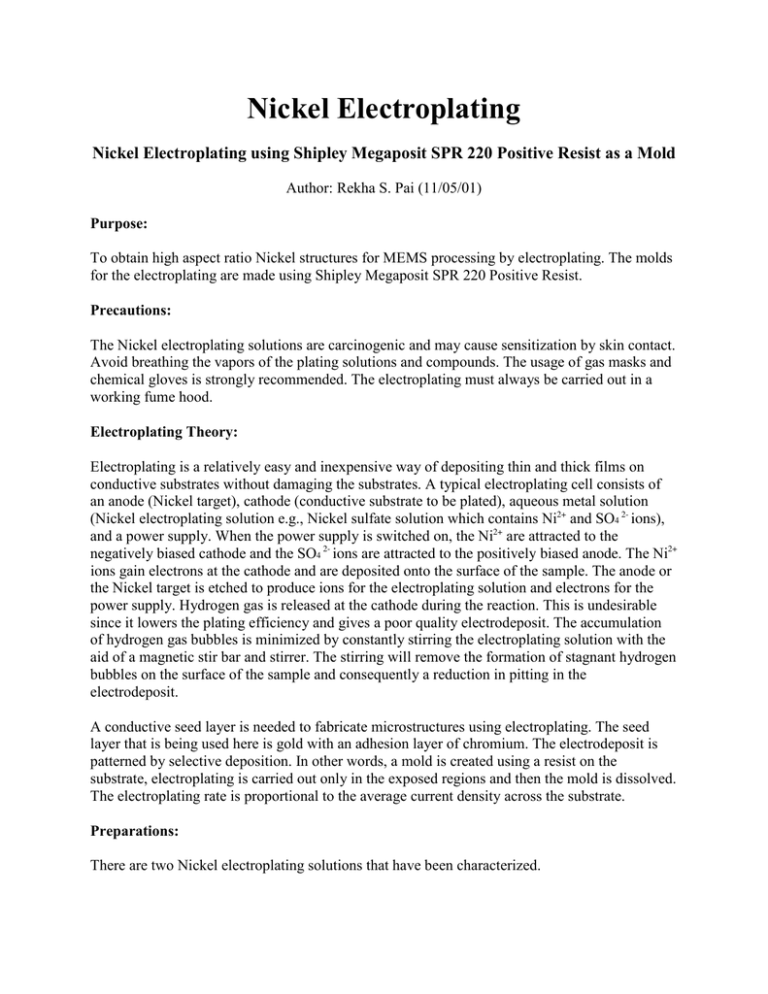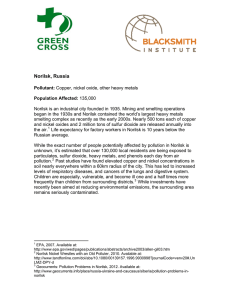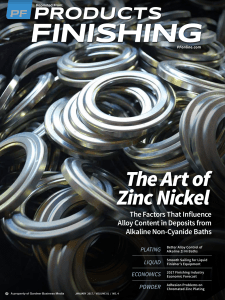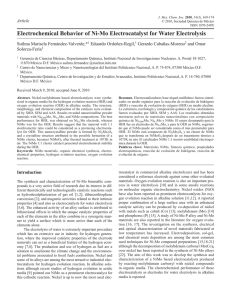Nickel Electroplating
Anuncio

Nickel Electroplating Nickel Electroplating using Shipley Megaposit SPR 220 Positive Resist as a Mold Author: Rekha S. Pai (11/05/01) Purpose: To obtain high aspect ratio Nickel structures for MEMS processing by electroplating. The molds for the electroplating are made using Shipley Megaposit SPR 220 Positive Resist. Precautions: The Nickel electroplating solutions are carcinogenic and may cause sensitization by skin contact. Avoid breathing the vapors of the plating solutions and compounds. The usage of gas masks and chemical gloves is strongly recommended. The electroplating must always be carried out in a working fume hood. Electroplating Theory: Electroplating is a relatively easy and inexpensive way of depositing thin and thick films on conductive substrates without damaging the substrates. A typical electroplating cell consists of an anode (Nickel target), cathode (conductive substrate to be plated), aqueous metal solution (Nickel electroplating solution e.g., Nickel sulfate solution which contains Ni2+ and SO4 2- ions), and a power supply. When the power supply is switched on, the Ni2+ are attracted to the negatively biased cathode and the SO4 2- ions are attracted to the positively biased anode. The Ni2+ ions gain electrons at the cathode and are deposited onto the surface of the sample. The anode or the Nickel target is etched to produce ions for the electroplating solution and electrons for the power supply. Hydrogen gas is released at the cathode during the reaction. This is undesirable since it lowers the plating efficiency and gives a poor quality electrodeposit. The accumulation of hydrogen gas bubbles is minimized by constantly stirring the electroplating solution with the aid of a magnetic stir bar and stirrer. The stirring will remove the formation of stagnant hydrogen bubbles on the surface of the sample and consequently a reduction in pitting in the electrodeposit. A conductive seed layer is needed to fabricate microstructures using electroplating. The seed layer that is being used here is gold with an adhesion layer of chromium. The electrodeposit is patterned by selective deposition. In other words, a mold is created using a resist on the substrate, electroplating is carried out only in the exposed regions and then the mold is dissolved. The electroplating rate is proportional to the average current density across the substrate. Preparations: There are two Nickel electroplating solutions that have been characterized. 1. Homemade Nickel electroplating solution (Ahn, Chong; Allen, Mark; Georgia Institute of Technology) Material Quantity Nickel Sulfate 200g/L Nickel Chloride 5g/L Boric Acid 25g/L Saccharin 3g/L 2. Nickel "S" Sulfamate electroplating solution from Technics Inc. Limited. (Website: http://www.technic.com/ Illinois Sales Office Tel. No.: 773-262-2662) Prepare the solutions and pour them into a beaker. Add 2ml of Kodak Photoflo (wetting agent) to every 100ml of electroplating solution if the feature sizes are below 10μm. Stir the solution using a magnetic stir bar for about an hour at room temperature. The calculations for the time and desired thickness are done prior to the electroplating as shown below. Alternatively, the graphs may be used. 1. Find the exposed seed layer area A (the area which is not covered by the resist) 2. Choose the desired current density J in mA/m2. Smaller current densities give better quality films but take more time. 3. Calculate the amount of current needed I. I=J*A 4. Calculate the time it will take using the equation: Time = (t*ρ *F*n)/(J*M) Where t = Film Thickness in μm ρ = Density of Ni = 8.9g/cm3 F = Faraday constant = 96488 C/mol n = No. of electrons available in Nickel = 2 J = Current Density in mA/cm2 M = Molecular weight of Nickel Electroplating solution = 58.71g/mol Substituting the above values: Time = (48.756217 *t)/ J Where Time = Time measured in min Procedure: 1. Clean the wafer using a standard base clean (Initial wafer clean SOP). 2. Deposit 10nm thick adhesion layer of Chromium and 100nm thick layer of gold as conductive seed layer using sputtering (Technics 4604 sputterer SOP). Typical parameters for sputtering are: Chromium ~10nm = RF sputtering at 250W, 15mtorr for 30secs Gold ~100nm = DC sputtering at 350W, 20mtorr for 4mins 1. Spin on Shipley Megaposit SPR220 resist and pattern it (Shipley Megaposit SPR220 Positive Resist SOP). Also, cover the back of the sample with resist so that selective deposition takes place on the front side of the sample only. Typical photolithography parameters are as follows: Back of wafer: Solitec spinner - Spread at 53rpm for 0.2secs. Spin at 4000rpm for 10secs. Soft bake on Data Plate programmable hot plate at 115ËšC for 3mins. Typical resist thickness obtained ~6µ m Front of wafer :Solitec spinner - Spread at 53rpm for 0.2secs. Spin at 2500rpm for 10secs Soft bake in Blue-M vacuum oven at 100ËšC for 30mins. Pattern the front of the wafer using AB-M mask aligner with an exposure time of 10secs. Develop using Microposit 452 developer for 2.5mins. Typical resist thickness obtained ~9µ m. 2. Acetone the resist off the part of the substrate where it is to be attached to the clip. The photoresist acts as an insulator. Therefore, this is done to get good contact to the seed layer. 3. Connect the negative terminal of the Keithley 220 current source to the ground and the wafer substrate. 4. Connect the positive terminal of the Keithley 220 current source to the Nickel target. An illustration for the typical setup is shown in Fig.1. 5. A picture of the actual setup is shown in Fig.2. Make sure that there is good contact between the sample and the clips of the current source. Fig.1. Illustration of typical setup for Nickel Electroplating Fig.2. Setup for Nickel Electroplating 6. Pour the electroplating solution inside a beaker. Put the magnetic stir bar inside the beaker and set it on the Corning stirrer. Switch on the stirrer and make sure the solution is being stirred constantly at room temperature. Turn the knob on the stirrer to SLOW. 7. Switch on the Keithley 220 current source by pressing the red POWER switch. Press the SOURCE button and enter the desired current using the data and EXPONENT buttons. Press ENTER to set the current value. The current range is 20μm to 101mA. 8. Check the voltage limit using the V-LIMIT button. Set an appropriate value using the data buttons and then pressing ENTER (Default value is 3V and voltage range is 1V105V). 9. Apply this current to the sample by pressing the OUTPUT/OPERATE button. The current is applied to the sample before introducing it into the electroplating solution so that the sample surface is activated. This ensures that plating starts immediately on the surface since nickel ions will be immediately attracted to the sample. 10. Lower the stand holding the sample and the target slowly into the electroplating solution. Make sure that the clips are not exposed to the solution. 11. If the V-LIMIT LED is flashing after step 12, then either the V-LIMIT needs to be increased or the contacts with the clips need to be checked to ensure good contact. 12. Electroplating is carried out for the desired time in order to obtain the desired thickness of Nickel. 13. Switch off the current source after the requisite time. Rinse the sample with DI water and blow-dry with N2 gun. 14. Inspect under the microscope and measure the step height using the Tencor profilometer. If the results are satisfactory, acetone off the sample to dissolve the SPR220 mold. 15. Inspect under the microscope and make sure that all the resist has been removed. SEMs of typical results of Nickel electroplating are shown below: Fig.3. 2µ µ m spokes of Nickel Fig.4. 8µ µ m tall structures of Nickel





